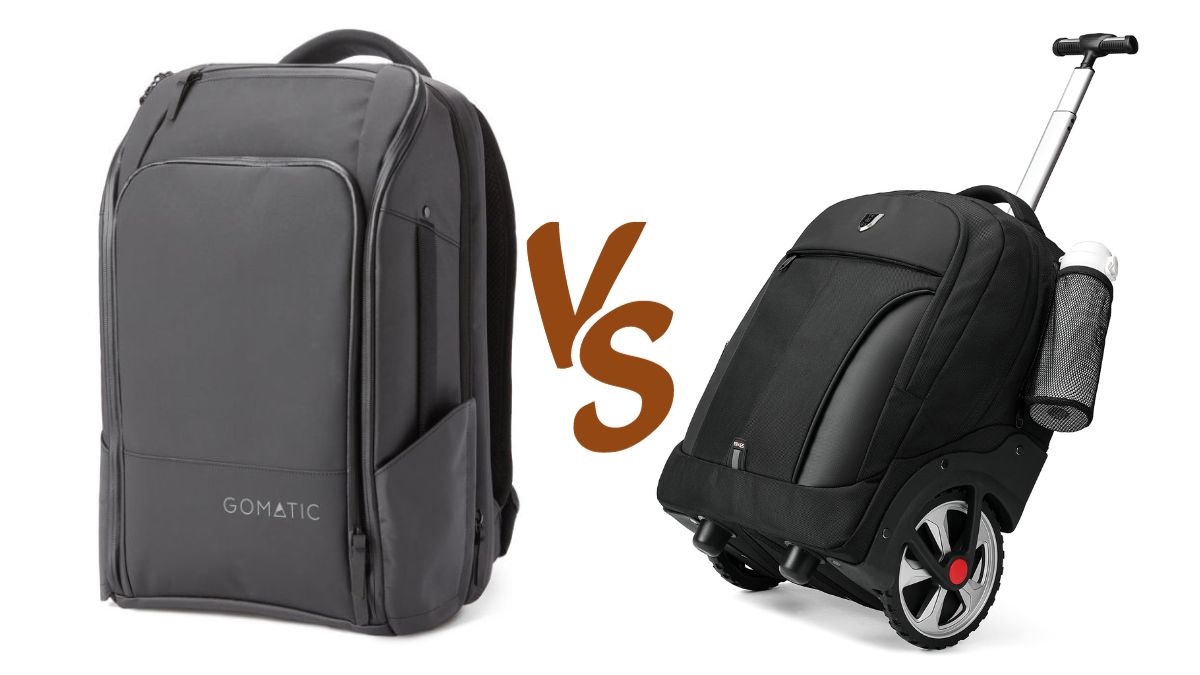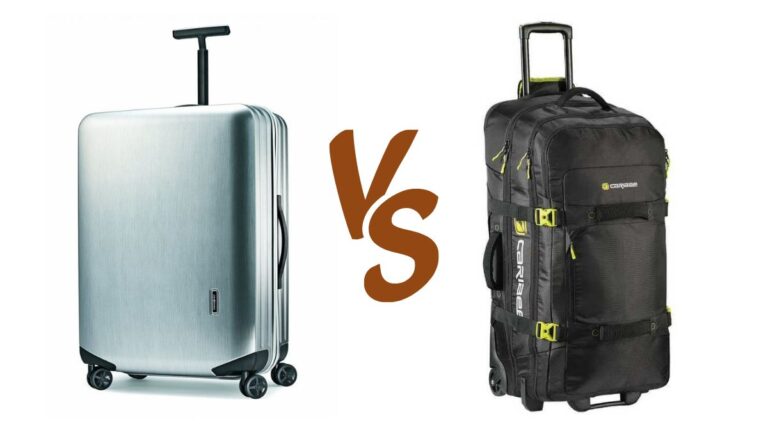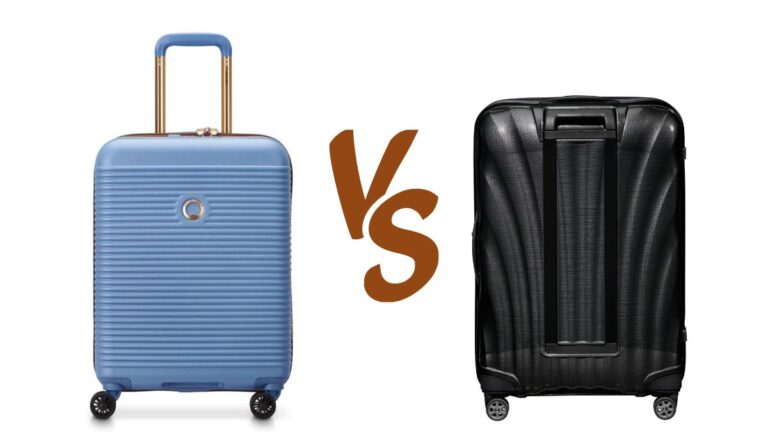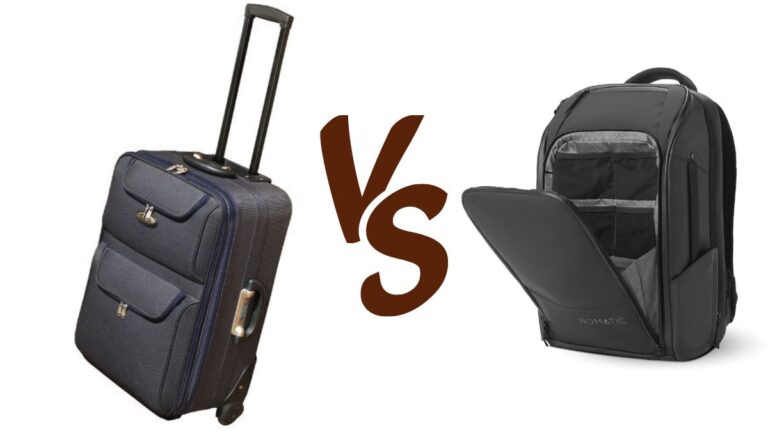Travel Pack Vs. Wheeled Backpack: Comparing Sizes & Uses

As participants in Amazon Associates and other programs, we earn from qualifying purchases. This comes at no additional cost to you. For more details, see our Affiliate Disclosure.
In the world of travel gear, the right baggage can elevate your journey to new heights. Among the many choices, travel packs and wheeled backpacks have emerged as favorites. Both have their unique benefits and come in a range of sizes. This article will guide you through the differences, helping you decide which fits best for your upcoming trips.
HIGHLIGHTS
- Wheeled backpacks are best suited for journeys through city streets and airports, while travel packs are designed for uneven terrains and adventurous paths.
- For short trips like weekend getaways or business ventures, a wheeled backpack offers convenience, but longer journeys require the comfort and durability of a travel pack.
- While wheeled backpacks can have a higher initial cost and potential maintenance expenses, travel packs often prove to be a more value-driven investment over time.
Understanding the Basics: What is a Travel Pack?
When you think of a travel pack, envision a backpack tailored for the passionate traveler. It’s more than just storage; it’s an extension of the adventurer’s spirit.
Unlike the casual daypacks or specialized hiking backpacks, a travel pack stands out with its functional features. Most come with a structured shape that ensures your belongings aren’t crushed or misplaced. They often have multiple compartments for that meticulous organizer in all of us, ensuring that every item has its place.
Materials matter. Most travel packs are crafted with resistant materials to withstand the wear and tear of constant movement. And for those who’ve faced the challenge of fishing for a charger or a travel journal, many travel packs offer the convenience of a front-loading system, reminiscent of a suitcase.
Security isn’t an afterthought either. With features like lockable zippers, they’re a nod to every traveler’s subtle fear: theft. Whether it’s a month-long backpacking trip or a weekend city escape, holding a travel pack is like clutching a reliable friend’s hand, ready to explore the unknown together.
Rolling with Ease: The Features of Wheeled Backpacks
Wheeled backpacks are the epitome of modern travel convenience. Merging the pull-along ease of wheeled luggage with the hands-free advantage of a traditional backpack, they represent the best of both travel worlds.
Imagine racing through an expansive airport terminal. The smooth wheels and retractable handle mean your gear glides effortlessly beside you. But, as soon as you hit the cobbled streets of a historic European town or the rugged terrains of a nature trail, the backpack straps come out, allowing you to carry your belongings comfortably on your back.
Organization is another forte of wheeled backpacks. With multiple compartments, they ensure that everything, from your travel documents to your portable charger, has its own designated space. These bags are often constructed with durable materials to endure the strain of constant movement and varied terrains.
Wheeled backpacks cater to the unpredictable nature of travel. Whether you’re navigating the smooth hallways of a hotel or trekking up a hill, they offer flexibility that few other bags can match, making every journey a bit more seamless.
Size Matters: Comparing Storage Capacities
When selecting a bag for your travels, storage capacity is undeniably a significant factor. After all, your choice determines how much you can carry, whether it’s essentials for a weekend getaway or gear for a month-long adventure. Both travel packs and wheeled backpacks come in various sizes, catering to different travel needs.
Travel Packs generally start at about 40 liters, suitable for weekend trips or light packers. For longer excursions, they can go up to 70 liters or more, accommodating everything from clothing to camping gear. Their design, with multiple compartments and pockets, ensures optimal use of space.
Wheeled Backpacks, on the other hand, might start a tad smaller due to the inclusion of wheels and a retractable handle. The average small wheeled backpack might begin at 30 liters, ideal for short trips. For extended travels, they can range up to 65 liters, providing ample space for all essentials while ensuring mobility remains uncompromised.
To help you visualize the comparison:
| Bag Type | Starting Capacity | Maximum Capacity |
|---|---|---|
| Travel Pack | 40 liters | 70+ liters |
| Wheeled Backpack | 30 liters | 65 liters |
While capacity is essential, it’s also crucial to consider how you pack. Efficient packing can often mean the difference between fitting everything in comfortably and wrestling with zippers. Regardless of your choice, both bags offer versatility in terms of storage, ensuring you have what you need, when you need it.
Use-Cases: When to Opt for a Travel Pack
Selecting the right travel gear often hinges on understanding your journey’s demands. The travel pack, with its unique design and features, is best suited for specific scenarios. Here’s when a travel pack might be your go-to choice:
- Backpacking Adventures: If you’re planning on backpacking through various countries or remote locations, the ergonomic design of travel packs makes them a preferred choice. Their weight distribution and adjustable straps ensure you can carry them for extended periods without discomfort.
- Varied Terrains: For those venturing into areas where wheeled luggage is impractical, like sandy beaches, forest trails, or cobbled streets, a travel pack’s mobility becomes invaluable.
- Flexible Travel Plans: If your itinerary is fluid, with frequent location changes or unpredictable lodging situations, the portability and easy accessibility of a travel pack will serve you well.
- Compact Storage: In situations where storage space is at a premium, like staying in hostels or smaller accommodations, the malleable nature of a travel pack allows it to fit into tighter spaces more easily than rigid suitcases.
- Security Concerns: Travel packs often come with anti-theft features like lockable zippers and hidden pockets. If you’re traveling to places where pickpocketing or bag theft is a concern, these features can provide added peace of mind.
- Personal Preference: Sometimes, it’s just about the feel. Many travelers appreciate the closer connection to their belongings and the sense of adventure that wearing a pack brings. It’s a symbol of the wanderlust spirit, and for some, there’s no replacement for that.
A travel pack is a versatile and robust choice for those seeking mobility, security, and a touch of the adventurer’s essence in their journeys.
Use-Cases: When a Wheeled Backpack is Your Best Bet
Wheeled backpacks have carved a niche in the travel gear world, offering a hybrid solution for varied travel demands. They shine in certain scenarios, making them the optimal choice for specific types of journeys. Here’s when you might want to consider a wheeled backpack:
- Urban Exploration: When traversing city streets, navigating airports, or hopping on and off trains, the convenience of wheels is unparalleled. Smooth surfaces become a breeze, and your back thanks you during those long city walks.
- Mix of Terrains: If your trip involves both urban and rough terrains, a wheeled backpack provides the flexibility to roll or carry your gear as needed, adjusting to the environment seamlessly.
- Health Considerations: For travelers with back issues or those who prefer not to carry weight for extended periods, the option to wheel their belongings can be a game-changer.
- Professional Trips: For those traveling for business or attending conferences, a wheeled backpack offers the organization of a business bag with the added advantage of mobility, especially when you’re in a rush.
- Family Travel: Parents often juggle multiple bags and responsibilities, especially with younger children. A wheeled backpack allows for hands-free moments when needed, making it easier to manage kids and luggage simultaneously.
- Short Getaways: For weekend trips or quick getaways, the compact nature of smaller wheeled backpacks is perfect. They’re easy to store in overhead compartments and usually adhere to most airlines’ carry-on size requirements.
- Aesthetic and Comfort: The modern look of many wheeled backpacks, combined with padded straps and ergonomic design, often appeals to travelers who want both style and substance.
The choice to opt for a wheeled backpack hinges on the balance of convenience and adaptability. They are perfect for those who appreciate the traditional backpack but wouldn’t mind a reprieve from the weight now and then.
Durability and Maintenance: Which Lasts Longer?
Travel gear is an investment, and understanding its lifespan and maintenance needs is crucial for travelers who demand value for their money. When it comes to travel packs and wheeled backpacks, durability often comes into question given their varied use-cases.
Travel Packs
These are typically designed with durability in mind. Made from robust materials like ripstop nylon or polyester, they resist wear and tear from constant movement, friction, and weight.
Since they lack mechanical components, there’s less that can break or malfunction. Simple maintenance, like occasional cleaning and ensuring they are stored in dry places, can extend their life significantly.
Wheeled Backpacks
While they combine the best of both worlds in terms of function, the inclusion of wheels and retractable handles introduces more potential points of failure. Wheels can wear out or get jammed, and handles can become faulty. The bottom area, which often bears the brunt of dragging, is more prone to wear out.
Regular maintenance, such as checking and oiling the wheels and being mindful of weight limits, can ensure a longer lifespan. However, even with diligent care, the mechanical components might require occasional replacements.
When it comes to sheer durability and minimal maintenance, travel packs have the edge. Their straightforward design and rugged materials typically outlast the mechanical components found in wheeled backpacks.
However, with proper care, a wheeled backpack can still serve a traveler well for many adventures. The key is understanding the trade-offs and ensuring you pick the option that aligns with your travel style and maintenance comfort level.
Comfort and Portability: Carrying Experiences Compared
Comfort and portability often top the list of traveler concerns, particularly during prolonged journeys or when navigating diverse terrains. Both travel packs and wheeled backpacks offer unique carrying experiences. Let’s dissect their comfort levels and portability:
Travel Packs
These are designed with the human body in mind. Padded shoulder straps distribute weight evenly across the shoulders, and waist belts often offload the strain from the back, transferring it to the hips. Breathable back panels in many models reduce sweating, and adjustable straps allow wearers to find their perfect fit.
This ensures optimal comfort during long treks or when navigating through crowds. The very essence of a travel pack is portability, allowing you to be nimble and move freely without the constraints of wheels.
Wheeled Backpacks
The primary advantage here is the option to wheel your gear when you don’t feel like carrying it. This is a godsend in urban environments, long airport corridors, or any smooth terrain. However, when used as a backpack, they might not be as comfortable as travel packs.
The internal framework for wheels and handles can sometimes create pressure points against the back. Additionally, they tend to be heavier because of the added mechanical components. This means even when you’re carrying a similar load, a wheeled backpack might feel heavier than a regular travel pack.
In terms of pure comfort and portability, the travel pack emerges as the clear winner. Its design caters specifically to the ergonomics of carrying, ensuring that weight is distributed optimally and that the traveler can move with agility.
While wheeled backpacks offer the undeniable convenience of rolling, when it comes down to the carrying experience, travel packs have the upper hand.
Pricing: Getting the Best Bang for Your Buck
Price is an undeniable factor when choosing travel gear. Both initial investment and long-term value come into play. Let’s dive into the pricing dynamics of travel packs and wheeled backpacks to identify which offers better value for your money.
Travel Packs
Generally, travel packs offer a wide pricing range, driven by factors such as brand reputation, materials used, design intricacies, and additional features. Being less mechanically complex, they often have fewer components that can drive up costs.
Over time, the maintenance costs are usually minimal, primarily if you care for the bag by cleaning it regularly and avoiding excessive wear and tear.
Wheeled Backpacks
These typically start at a higher price point than basic travel packs due to their mechanical components, such as wheels and retractable handles.
The combination of backpack and suitcase features also requires more intricate design and manufacturing processes, which can influence the price. Maintenance and potential replacement parts, like wheels or handles, can add to the long-term cost.
When evaluating the initial investment, longevity, and potential maintenance costs, travel packs provide better value for your money. They generally offer durability and functionality at a more affordable price point and have fewer components that could require future replacements.
While wheeled backpacks have their undeniable advantages, when it comes to getting the most bang for your buck, travel packs take the crown.
Making Your Decision: Factors to Consider
Making a choice between a travel pack and a wheeled backpack depends on your individual travel needs. Think about where you’re going most often. If your trips lead you through city streets and airports, the convenience of a wheeled backpack is hard to beat. Yet, for those who regularly venture into uneven landscapes or love the thrill of an off-the-beaten-path adventure, the travel pack offers durability and ease.
Consider the length and nature of your trips too. Weekend getaways or business trips might favor the wheeled approach. On the flip side, long journeys, where comfort is paramount, will find a trusty companion in the travel pack.
Budget is always a significant factor. While wheeled backpacks offer versatility, they can come with a heftier price tag and potential maintenance costs. On the other hand, travel packs, with their simplicity and rugged design, often offer more value for money over time.
Finally, there’s the matter of personal preference. Some travelers simply love the feeling of freedom that a backpack brings, embodying the spirit of a wanderer. Others appreciate the option to switch between carrying and rolling, especially during those longer transit days.
In the end, if versatility in urban settings is your priority, a wheeled backpack might be your best companion. But for longevity, comfort, and a sense of adventure, the travel pack often reigns supreme. It’s all about aligning your choice with your travel aspirations and needs.






